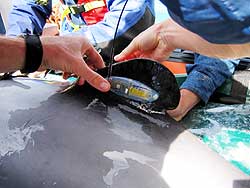|
Dr Duignan was directly involved in the tagging programme. Marine mammal expert Dr Padraig Duignan says the research is crucial to begin to build up a bank of knowledge about these endangered animals. “We are starting to create a set of reference values for the species. If we can test others in future, we will have a good set of data to compare against. If they are struck by an epidemic, or even if we have live single stranded animals, we at least will have some baseline data from healthy dolphins to assist in making diagnoses.”
He says the live capture of the dolphins provided an excellent opportunity to assess the health of these animals. “There has never been a health assessment done on any free living dolphin species in New Zealand. Any information we have is based on dead animals which we have autopsied, not animals in the wild. This provided a unique opportunity to do that.”
Each animal was captured using a method developed by Dr Alan Baker for capturing Hector’s dolphins in the late 70s and early 80s at Cloudy Bay.
Small custom-designed transmitter tags were attached
that send data on the dolphin’s movements via satellite
to the researchers. This provides information on
seasonal migrations, as well as distance travelled
and day and night time movements.
The tags are attached by two nylon pins secured
using metal nuts that will corrode in sea water
and release the tag after approximately three months.
Dr Duignan says the dolphins were out of the water for only a short time. Their heart rate and respiration were monitored constantly while out of the water and once released they swam away normally to rejoin their pod.
The research is being led by Dr Greg Stone from the New England Aquarium in Boston, who has pulled together a team of experts, including Dr Duignan and Gareth Jones, Massey University, Dr Scott Baker and Kirsty Russell, University of Auckland, Dr Jonas Teilmann, from the Danish Ministry of the Environment, Dr Katja Geschke, Wellington Zoo, and Alastair Hutt, Department of Conservation. The trial is also evaluating the potential for this technique to be used on the critically endangered North Island Maui’s dolphin.
Initial satellite data has shown the dolphins’ daily movement patterns around the Peninsula and the distances they travel in a relatively short time. According to Dr Greg Stone the dolphins appear to have a home range but they also go on excursions outside this range. “One of the females, Te Ruahine, tends to travel long distances from the Peninsula and spends a lot of time outside the boundaries of the Marine Mammal Sanctuary established to protect the dolphins from fisheries.”
Dr Duignan says the preliminary data shows the dolphins were in good health. Parasites were present as expected but there was no indication of the deadly Aspergillus infection that has recently killed two Hector’s and one Maui’s dolphin. An ultrasound was used to determine how much blubber each animal carried as an indication of body condition. Blood samples were taken to look at cell characteristics and to determine the health of vital organs. Plasma was also collected to check hormone levels, such as cortisol that could indicate chronic stress levels, as well as oestrogen, testosterone and progesterone to give a reproductive hormone profile and an indication of maturity.
Genetic structures and diversity of the immune system genome will be tested and a panel of serum tests run against different pathogens, such as brucellosis, leptospirosis, influenza, calicivirus or distemper. Distemper is known to have caused many deaths in dolphin populations in other countries. Dianne Knight at Massey is also conducting a genetic test for this virus.
The research trial on the Banks Peninsula was given full support by Ngai Tahu.
Top
|

